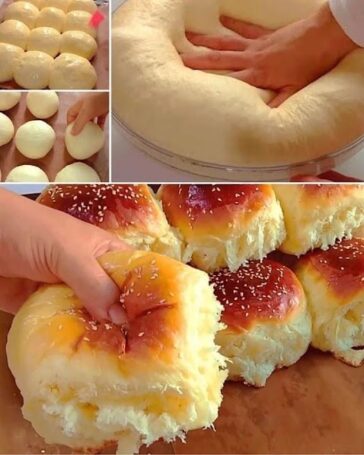
Brioche, a crown jewel in the world of bread, is celebrated for its rich, tender crumb and golden, buttery crust. This particular Milk Brioche recipe offers a twist on the traditional, incorporating both heavy cream and milk to create a loaf that’s not only luxuriously soft but also accessible to bakers of all skill levels. Whether you’re a seasoned baker or someone looking to dip their toes into the art of bread-making, this recipe promises to guide you through to a delicious outcome.
The beauty of brioche lies in its versatility. It can elevate a simple breakfast, transforming toast into a sumptuous affair, or serve as the foundation for an array of sophisticated desserts and savory sandwiches. This Milk Brioche, with its blend of heavy cream and milk, strikes a delightful balance between indulgence and lightness, making it a perfect candidate for any meal of the day.
Crafting this brioche at home is an invitation to engage with the tactile joys of baking. From the initial mixing of the dough to the final brush of simple syrup on the warm loaf, each step is a testament to the magic of turning simple ingredients into something extraordinary. With detailed guidance and a few expert tips, this Milk Brioche recipe is designed to inspire confidence in the kitchen and lead to a beautifully baked masterpiece that’s sure to impress.
Ingredients Explanation and Alternatives
- Heavy Cream: At room temperature for easier mixing. It enriches the dough, contributing to a tender and rich crumb.
- Milk: Also at room temperature to help activate the yeast. Whole milk is preferred for its fat content, but 1% or 2% can be used if you’re looking for a lighter option.
- Egg: Adds moisture and richness to the dough. Ensure it’s at room temperature for uniform mixing.
- Sugar: Provides sweetness and helps brown the crust. It also feeds the yeast, aiding in the dough’s rise.
- All-Purpose Flour: The main structure of the brioche. You can substitute part of it with cake flour for a finer texture or bread flour for more chewiness.
- Yeast: Active dry or instant yeast will work. Ensure it’s not expired for proper rise.
- Salt: Enhances flavor and controls yeast activity, ensuring the brioche doesn’t overproof.
- Egg Wash: Gives the brioche a beautiful golden finish.
- Simple Syrup: Applied after baking for a glossy sheen and slight sweetness.
Step-by-Step Instructions with Expanded Details
- Preparing the Dough: Starting with the stand mixer method, ensure your ingredients are at room temperature to facilitate even mixing and optimal yeast activation. If the dough is too sticky, adding flour gradually ensures you don’t dry out the dough too much. For those kneading by hand, the extended kneading time develops the gluten further, which is crucial for the bread’s texture.
- First Proof: The warm, moist environment is vital for the dough’s rise. This could be achieved in various ways, such as in a slightly warmed oven or even in a warm, draft-free corner of your kitchen. The goal is to see the dough double in size, indicating that the yeast has been actively fermenting.
- Shaping the Dough: This step is flexible, allowing you to create loaves, rolls, or a combination thereof. Shaping the dough not only determines the bread’s final form but also affects its texture. Tight shaping for loaves creates a fine crumb, while gently shaped rolls offer a more tender bite.
- Second Proof: Ensures the shaped dough rises adequately, leading to a light, airy bread. This step is crucial for developing the final volume and texture of your brioche.
- Baking: Positioning the rack in the center of the oven promotes even baking. The egg wash is key for a golden, shiny crust. Baking until golden brown ensures a delicious crust and fully cooked interior. The simple syrup brushed on after baking adds a lovely shine and slight sweetness, enhancing the bread’s appearance and flavor.
- Cooling and Serving: Allow the brioche to cool slightly before slicing to let the structure set, ensuring it doesn’t crumble when cut. Milk brioche is versatile, perfect for breakfast, as a snack, or even as part of a luxurious sandwich.
By understanding each ingredient’s role and the purpose behind each step, bakers can make informed adjustments to suit their preferences or available ingredients. This expanded guide should help you achieve a deliciously tender and flavorful milk brioche, perfect for a variety of occasions.
Leave a Comment